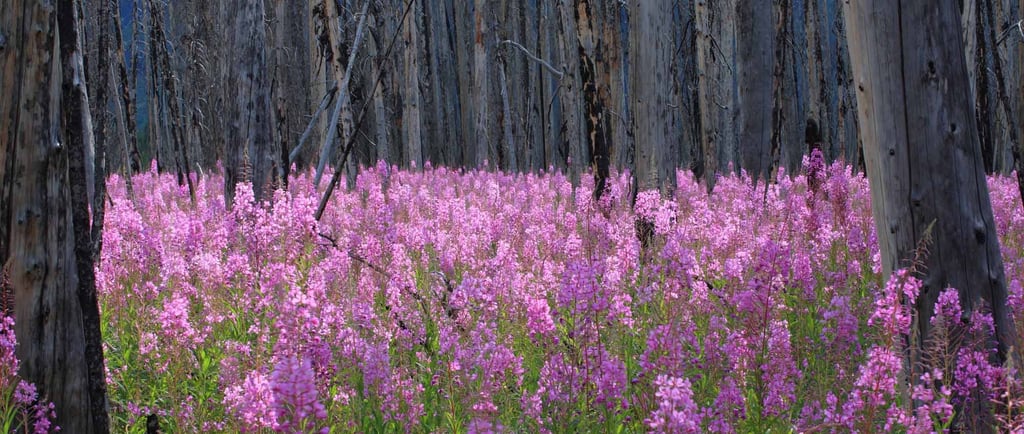🌸🔥 Fireweed: The Flower That Follows Fire 🐾
🌱 A follow-up story that connects Chapter The Seed and Chapter Ecology from the Biology Album. 🔥🌸 Through the story of the fireweed—one of the first plants to bloom after a wildfire—children are invited to witness the resilience of seeds and the quiet power of ecological renewal. When the forest is reduced to ash, it is the tiny, hidden seeds like fireweed that sense the signal to awaken. ☄️🌿 This story sparks a connection between the visible and invisible forces of nature: fire and germination, destruction and rebirth, animal helpers and floral pioneers. It opens doors to wonder: 💭 “Why does fire make some seeds grow? Which plants are the first to return—and who follows?” An invitation to observe, to question, and to marvel at nature’s cycles of regeneration. 🌍✨
BIOLOGY STORIES
7/8/20252 min read


Sometimes, on hot summer days, when the sun’s rays feel like they’re burning the earth, fires begin in the forests. 🌞🔥🌲 The flames leap and roar, swallowing trees and crackling under dry leaves. Animals run, smoke rises, and the sky turns orange with ash. 🌫️ And when it’s over… there is silence. The trees are blackened. The ground is grey. Everything seems still. Everything seems lost. For a moment, it looks like the forest is gone forever. But is it?
After a few rains… after the quiet settles back in… something surprising happens. From the ashes, a stem rises. A stem with narrow leaves and a bright, pink-purple blossom—🌸 Fireweed. After just a few days, little green shoots begin to appear, like whispers of hope. Soon the forest floor is covered in color—bright pink-purple flowers dancing where there was only ash before. 💜🌿
Fireweed got its name because it loves to grow after fire. In fact, it often grows best in burned ground, where sunlight is strong, and other plants haven’t returned yet. It’s one of nature’s brave explorers—what scientists call a pioneer species. 🌟🌿Fireweed’s roots stretch deep, and its seeds fly far, carried by silky white tufts that ride the wind like snowflakes. 🌬️☁️
Pioneer species are like the first visitors to a place that needs healing. They’re the ones that come before all the others, preparing the land and making it ready for new life to return. Fireweed grows fast, spreads wide, and helps hold the soil in place. Its flowers call to the bees 🐝, and its leaves feed little animals 🐇. It’s like rolling out a welcome mat for the whole forest to come back. 🌲🦉🦌
💬 In the north—Yukon Territory, Canada—this flower is so loved, it’s even pictured on the flag! 🇨🇦 In Alaska, porcupines nibble on its tender shoots. In Norway, it’s called geitrams, meaning “goat ramson,” because goats ( and also moose) love munching on it. In traditional herbal medicine, it was used to soothe skin and help with digestion. In Russian folklore, fireweed (called Ivan Chai) was brewed into a sweet tea believed to calm the heart. 🌿🍵
📸 Now, let’s look closely at this fireweed stalk together…
At the bottom, you’ll see the parts that have already finished blooming—these flowers are now turning into long green seed pods. 🌱In the middle, the blossoms are wide open—offering their bright magenta petals to bees and butterflies. 🐝💗And at the very top, you’ll see small buds—flowers not quite ready, still waiting their turn. 🌸 And in many countries, the blooming of fireweed helps tell time: when the flowers reach the top of the stalk, summer is nearly over. ☀️➡️🍂In many Arctic communities, people say: 👉 “When fireweed finishes blooming at the top, summer is almost gone.” So fireweed becomes a natural calendar, quietly marking the days. 📅🍂 And soon, when those seed pods at the bottom are ready…✨ Pop! They open suddenly—sending tiny, silky seeds flying into the sky. 🌬️☁️
Each one rides the wind like a traveler, looking for the next patch of open earth where fire once burned and life can begin again. 🌍💫
💭I wonder...What other seeds need fire or heat to wake up? Could there be trees or flowers that sleep until the fire sings its hot song?
🗺️ Would you like to research real forest fires around the world—and the plants that grew back first?
With Montessori joy,
Vanina 😊

